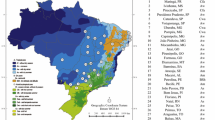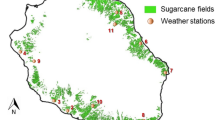Abstract
The use of crop simulation models with geographical information systems (GIS) has become an important tool to evaluate the sugarcane yield potential in different regions. Therefore, the objectives of the present study was to calibrate and test the FAO crop yield model to estimate the potential and actual sugarcane yields in the State of São Paulo to map these variables and define maximum yield increase considering a full irrigation system. The sugarcane crop yield was estimated by the FAO model with simulations for a period between 1974 and 2003 for 178 locations, using 10-day period weather data. The soil water holding capacity for each location was determined according to the predominant soil type in the region. The leaf area index and crop phenology parameters were adjusted in order to fit estimated and observed yields. We also inserted a frost factor into the model to improve its performance. The simulations considered the cycles of plant and ratoon crops, which were weighted to compose the annual potential and actual yields. The performance of the model was evaluated by the following statistical coefficients: R2, d, C and RMSE. The maps of sugarcane Yp and Ya were generated with linear models and their respective deviations in a GIS platform. The model performed with reasonable precision and good accuracy, as proved by the statistical coefficients: R2 = 0.58; d = 0.83 and C = 0.63. The RMSE was 5.0 Mg ha−1 and the mean error was 2 Mg ha−1.






Similar content being viewed by others
References
Alvares, C.A., J.L. Stape, P.C. Sentelhas, and J.L.M. Gonçalves. 2012. Modeling monthly mean air temperature for Brazil. Theoretical and Applied Climatology 110: 1–20.
Ambrosano, E.J., H. Cantarella, G.M.B. Ambrosano, E.A. Schammas, F.L.F. Dias, F. Rossi, P.C.O. Trivelin, T. Muraoka, R.C.C. Sachs, and R. Azcòn. 2011. Produtividade da cana-de-açúcar após o cultivo de leguminosas. Bragantia 70: 810–818.
ANA—Agência Nacional de Águas (ANA). 2010. Sistema de Informações Hidrológicas, Hidroweb. http://www2.ana.gov.br/Paginas/servicos/informacoeshidrologicas/redehidro.aspx (accessed November 23, 2010).
Astolpho, F., M.B.P. Camargo, M.J. Pedro Junior, W.J. Pallone Filho, and L. Bardin. 2005. Regionalização de risco de ocorrência de temperaturas mínimas absolutas anuais para o Estado de São Paulo com base em modelos probabilísticos e digitais de elevação. Bragantia 64: 139–148.
Belintani, N.G., J.T.S. Guerzoni, R.M.P. Moreira, and L.G.E. Vieira. 2012. Improving low-temperature tolerance in sugarcane by expressing the ipt gene under a cold inducible promoter. Biologia Plantarum 56: 71–87.
Camargo, A.P., and P.C. Sentelhas. 1997. Avaliação de diferentes métodos de estimativa da evapotranspiração potencial no Estado de São Paulo. Revista Brasileira de Agrometeorologia 5: 89–97.
Cuadra, S.V., M.H. Costa, C.J. Kucharik, H.R. Da Rocha, J.D. Tatsch, N.G. Inman-Bamber, C.C. Leite, and O.M.R. Cabral. 2012. A biophysical model of sugarcane growth. Global Change Biology Bioenergy 4: 36–48.
Darli, A.B., R.L. Cruz, C.J.B. Garcia, and L.H. Duenhas. 2008. Irrigação por gotejamento subsuperficial na produção e qualidade de cana-de-açúcar. Irriga 13: 1–11.
Diacono, M., A. Castrignano, A. Troccoli, D. de Benedetto, B. Basso, and P. Rubino. 2012. Spatial and temporal variability of wheat grain yield and quality in a Mediterranean environment: A multivariate geostatistical approach. Field Crops Research 131: 49–62.
Doorenbos, J., and A.H. Kassam. 1979. Yield response to water, 139. Rome: FAO (Irrigation and Drainage paper, 33).
EMBRAPA. 2006. Empresa Brasileira de Pesquisa Agropecuária (EMBRAPA), 306. Rio de Janeiro: Sistema Brasileiro de Classificação de Solos.
FAO—Food and Agriculture Organization (FAO). FAOSTAT. http://faostat.org/ (accessed December 21, 2012).
Farias, C.H.A., P.D. Fernandes, H.M. Azevedo, and J. Dantas Neto. 2008. Índices de crescimento da cana-de-açúcar irrigada e de sequeiro no Estado da Paraíba. Revista Brasileira de Engenharia Agrícola e Ambiental 12: 356–362.
Fernandes, J.L., J.V. Rocha, and R.A.C. Camargo. 2011. Sugarcane yield estimates using time series analysis of spot vegetation images. Scientia Agrícola 68(2): 139–146.
Gava, G.J., M.A. Silva, R.C. Silva, E.M. Jeronimo, J.C.S. Cruz, and O. Kölln. 2011. Produtividade de três cultivares de cana-de-açúcar sob manejos de sequeiro e irrigado por gotejamento. Revista Brasileira de Engenharia Agrícola e Ambiental 15: 250–255.
Gouvea, J.R.F., P.C. Sentelhas, S.T. Gazzola, and M.C. Santos. 2009. Climate changes and technological advances: impacts on sugarcane productivity in tropical southern Brazil. Scientia Agrícola 66: 593–605.
Greenland, D. 2005. Climate variability and sugarcane yield in Louisiana. Journal of Applied Meteorology 44: 1655–1666.
He, J.Q., M.D. Dukes, G.J. Hochmuth, J.W. Jones, and W.D. Graham. 2012. Identifying irrigation and nitrogen best management practices for sweet corn production on sandy soils using CERES-Maize model. Agricultural Water Management 109: 61–72.
IBGE—Instituto Brasileiro de Geografia e Estatística (IBGE). 2012. Sistema IBGE de Recuperação automática (SIDRA). http://www.sidra.ibge.gov.br/ (Accessed September 4, 2012).
Inman-Bamber, N.G., and D.M. Smith. 2005. Water relations in sugarcane and response to water deficits. Field Crops Research 92: 185–202.
Inman-Bamber, N.G. 1991. A growth model for sugarcane based on a simple carbon balance and the CERES-Maize water balance. South African Journal of Plant and Soil 8: 93–99.
Inman-Bamber, N.G. 2004. Sugarcane water stress criteria for irrigation and drying off. Field Crops Research 89: 107–122.
INMET, Instituto Nacional de Meteorologia (INMET). 2010. Normais Climatológicas do Brasil 1961–1990: versão revista e ampliada. Brasília, 465 p.
Jank, M.S. 2010. Uma matriz de combustíveis para o Brasil. In: Sousa, E.L.L., Macedo, I.C., editors. Etanol e bioeletricidade: a cana-de-açúcar no future da matriz energética. São Paulo, 315 p.
Keating, B.A., M.J. Robertson, R.C. Muchow, and N.I. Huth. 1999. Modelling sugarcane production systems I. Development and performance of the sugarcane module. Field Crops Research 61: 253–271.
Kucharik, C.J. 2003. Evaluation of a process-based agro-ecosystem model (Agro-IBIS) across the U.S. Corn Belt: Simulations of the Interannual Variability in Maize Yield Earth Interactions 3: 1–33.
Laclau, P.B., and J.P. Laclau. 2009. Growth of the whole root system for a plant crop of sugarcane under rainfed and irrigated environments in Brazil. Field Crops Research 114: 351–360.
Lapola, D.M., J.A. Priess, and A. Bondeau. 2009. Modeling the land requirements and potential productivity of sugarcane and jatropha in Brazil and India using the LPJmL dynamic global vegetation model. Biomass and Bioenergy 33: 1087–1095.
Martin, E.C., W. Stephens, R. Wiedenfeld, H.C. Bittensbender, J.P. Beasley, J.M. Moore, H. Neibling, and J.J. Gallian. 2007. Sugar, oil and fiber. In Irrigation to agricultural crops, 2nd ed, ed. R.J. Loscano, and R.E. Sojka, 279–335. Madison: ASA.
Maule, R.F., J.A. Mazza, and J.R.G.B. Martha. 2001. Produtividade Agrícola de cultivares de cana-de-açúcar em diferentes solos e épocas de colheita. Scientia Agrícola 58: 295–301.
Nassif, D.S.P., F.R. Marin, W.J. Pallone Filho, R.S. Resende, and G.Q. Pellegrino. 2012. Parameterization and evaluation of the DSSAT/Canegro model for Brazilian sugarcane varieties. Pesquisa Agropecuária Brasileira 47: 311–318.
Oliveira, E.C.A., F.J. Freire, A.C. Oliveira, D.E. Simões Neto, A.T. Rocha, and L.A. Carvalho. 2011. Produtividade, eficiência de uso da água e qualidade tecnológica de cana-de-açúcar submetida a diferentes regimes hídricos. Pesquisa Agropecuária Brasileira 46: 617–625.
Oliveira, R.A., R.S. Santos, A. Ribeiro, S. Zolnier, and M.H.P. Barbosa. 2012. Estimativa da produtividade da cana-de-açúcar para as principais regiões produtoras de Minas Gerais usando-se o método ZAE. Revista Brasileira de Engenharia Agrícola e Ambiental 16: 549–557.
Park, S.E., M. Robertson, and N.G. Inman-Bamber. 2005. Decline in the growth of a sugarcane crop with age under high input conditions. Field Crops Research 92: 305–320.
Paulino, J., C.A. Zolin, A. Bertonha, P.S.L. Freitas, and M.V. Folegatti. 2011. Estudo exploratório do uso da vinhaça ao longo do tempo. II. Características da cana-de-açúcar. Revista Brasileira de Engenharia Agrícola e Ambiental 15: 244–249.
Penè, C.B., S. N’ Diaye, and C. N’Guessan-Konan. 2012. Sprinkler irrigation and soil tillage practices in sugarcane plantations as influence by soil texture and water storage in northern Ivory Coast. Journal of Appied Bioscience 54: 3916–3924.
Pereira, A.R., L.R. Angelocci, and P.C. Sentelhas. 2002. Agrometeorologia: fundamentos e aplicações práticas, 478. Guaíba: Agropecuária.
Picoli, M.C.A., B.F.T. Rudorff, R. Rizzi, and A. Giarolla. 2009. Índice de vegetação do sensor MODIS na estimativa da produtividade agrícola da cana-de-açúcar. Bragantia 68: 789–795.
Prado, H. 2008. Pedologia Fácil: aplicações na agricultura. Piracicaba: SP: Insituto Nacional de Pesquisas Espacai. 145 p.
Rodriguez, E., C.S. Morris, J.E. Belz, E.C. Chapin, J.M. Martin, W. Daffer, and S. Hensley. 2005. An assessment of the SRTM topographic products. Technical Reports, 143 p.
Rudorff, B.F.T., D.A. Aguiar, W.F. Silva, L.M. Sugawara, M. Adami, and M.A. Moreira. 2010. Studies on the rapid expansion of sugarcane for ethanol production in Sao Paulo State (Brazil) using Landsat Data. Remote Sensing 2: 1057–1076.
Sentelhas, P.C., A.A. Ortolani, and J.R.M. Pezzopane. 1995. Estimativa da temperatura mínima de relva e da diferença de temperatura entre o abrigo e a relva em noites de geada. Bragantia 54: 437–455.
Silva, M.A., E.M. Jeronimo, and A. Lúcio. 2008. Perfilhamento e produtividade de cana-de-açúcar com diferentes alturas de corte e épocas de colheita. Pesquisa Agropecuária Brasileira 43: 979–986.
Singels, A., M. van den Berg, M.A. Smit, M.R. Jones, and R. van Antwerpen. 2010. Modelling water uptake, growth and sucrose accumulation of sugarcane subjected to water stress. Field Crops Research 117: 59–69.
Tao, F., M. Yokozawa, and Z. Zhang. 2009. Modelling the impacts of weather and climate variability on crop productivity over a large area: A new process-based model development, optimization, and uncertainties analysis. Agricultural and Forest Meteorology 149: 831–850.
Tassio Junior, L.C., M.O. Marques, A. Franco, G.A. Nogueira, F.O. Nobile, F. Camilotti, and A.R. Da Silva. 2007. Produtividade e qualidade de cana-de-açúcar cultivada em solo tratado com lodo de esgoto, vinhaça e adubos minerais. Engenharia Agrícola 27: 276–283.
Teruel, D.A., V. Barbieri, and J.R.L.A. Ferraro. 1997. Sugarcane leaf area index modeling under diferente soil water conditions. Scientia Agrícola, Special Edition: 39–54.
Thornthwaite, C.W., and J.R. Mather. 1955. The water balance, 104. Philadelphia: Publications in Climatology, Drexel Institute of Technology.
Tilley, L., and L.S. Chapman. 1999. Benchmarking Crop Water Index for the Queensland Sugar Industry. Brisbane: Burea of Sugar Experiment Stations and Canegrowers.
Willmott, C.J., S.G. Ackleson, R.E. Davis, J.J. Feddema, K.M. Klink, D.R. Legates, J. O’Donnell, and C.M. Rowe. 1985. Statistics for the evaluation and comparison of models. Journal of Geophysical Research 90: 8995–9005.
Yamori, W., K. Noguchi, and I. Terashima. 2005. Temperature acclimation of photosynthesis in spinach leaves: analyses of photosynthetic components and temperature dependencies of photosynthetic partial reactions. Plant and Cell Environments 28: 536–547.
Author information
Authors and Affiliations
Corresponding author
Rights and permissions
About this article
Cite this article
Monteiro, L.A., Sentelhas, P.C. Potential and Actual Sugarcane Yields in Southern Brazil as a Function of Climate Conditions and Crop Management. Sugar Tech 16, 264–276 (2014). https://doi.org/10.1007/s12355-013-0275-0
Received:
Accepted:
Published:
Issue Date:
DOI: https://doi.org/10.1007/s12355-013-0275-0




